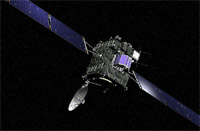Good night! European comet chaser Rosetta goes into hibernation
09 Jun 2011
After having travelled through space for more than seven years, on 8 June 2011, the Rosetta spacecraft was put into hibernation till 10:00 GMT on 20 January 2014. To reduce energy consumption, the European probe will be flying in 'economy mode' as it heads towards its destination, the comet 67P/Churyumov-Gerasimenko.
 Only heaters and an "alarm clock" have been left running.
Only heaters and an "alarm clock" have been left running.
But this will be no break for researchers at the German Aerospace Center (Deutsches Zentrum für Luft- und Raumfahrt; DLR); they will continue to train in preparation for Rosetta's arrival in May 2014. Six months after reaching the comet, Philae, the Rosetta lander, will become the first spacecraft to land on a comet.
Rosetta has travelled a long way since 2 March 2004, but it still has a long journey ahead. On its way to comet 67P/Churyumov-Gerasimenko, the spacecraft has captured images of the asteroids Steins and Lutetia during high-speed flybys, and has also passed close to Earth and Mars on several occasions. Rosetta has now been placed in a dormant state to enable it to reach its destination safely. "At the moment, the probe is too far from the Sun to maintain full operations using solar power," explains Stephan Ulamec of the DLR Microgravity User Support Center (MUSC) in Cologne. This is where the lander control centre, from where the Philae lander will be operated when it is on 67P/Churyumov-Gerasimenko, is located. "The spacecraft will remain pointed towards the Sun over the next two-and-a-half years, but only a clock, some heaters that are part of the thermal control system and a radio receiver will remain in operation."
Training for landing
Until the spacecraft and its lander reach their destination, the researchers will continue to train for what is the most difficult manoeuvre of the mission – setting the lander down on the comet's surface. With a diameter of about four kilometres, the comet is rather small; its gravity is just one ten-thousandth that of Earth's. Weighing about 100 kilograms on Earth, Philae becomes a ten-gram lightweight on 67P/Churyumov-Gerasimenko. "We still know nothing about the surface of the comet. Is it hard? Is it rough? What is the comet's axis of rotation?" The landing manoeuvre has been tested using what is known as a ground reference model – a replica of the lander constructed from spare parts. Using this model and their software, researchers are able to simulate, not only the sequence of operations that will be carried out during the landing in November 2014, but the operations on the surface of the comet as well. "Until arrival, we will be going through various descent scenarios and the use of the instruments on board the lander," explains Ulamec, the project manager for Philae.






























